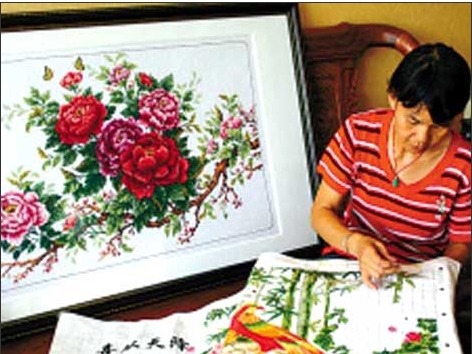
Cross-stitching, a type of embroidery, involves stitching one cross after another onto a fabric grid to form different patterns. Cross-stitched handkerchiefs and clothing accessories are unsophisticated and simple yet durable.
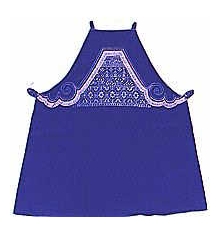
Cross-stitching is popular all across China (especially in southernShaanxi Province) and cross-stitched handicrafts are much loved by the Chinese people. Besides theHan nationality, people of many ethnic minorities in China also adore the craft, including the Dong, Miao and Qiang people.
In western China's rural areas, cross-stitching is nearly always executed with indigo blue thread on coarse, white cotton fabric. One- or two-colored embroidery made by peasants is perhaps the most striking of all, showing off its complex designs.
One of the most important and widespread functions of cross-stitching has been to adorn peasants' garments and household linen, often as a way of indicating family wealth and status in the community. Peasant embroidery is a purely domestic skill that is passed down through generations from mothers to their daughters. The stitching is simple and the fabric is readily available -- usually in the form of woven linen or cotton. Although thread colors areoften limited to just two or three types, they are beautifully dyed and often accentuated by dark brown or black outlines.
Origin and spread
From historical and archaeological evidence, there is not yet enough accurate information to trace the exact origins of cross-stitched embroidery. Some historians, however, suggest that the development of cross-stitching is greatly owed to the craftsmanship of the Chinese since this type of embroidery is known to have flourished during theTang Dynasty(618-907) and a strong rural tradition of cross stitching still existed in the area during the early 20th century.
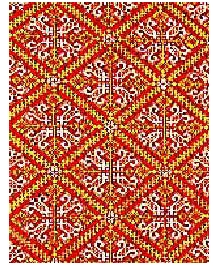
It is feasible that techniques and designs spread from China via India and Egypt to the great civilizations of Greece and Rome and then to the eastern Mediterranean and the Middle East. An alternative school of thought says that the spread of cross-stitched embroidery may have gone in the opposite direction since the first important migration of foreigners into China took place during the Tang Dynasty. Many Persians, Arabs and travelers from Greece and India followed the silk routes into China and eventually settled there. There is evidence that these immigrants influenced the designs of Chinese arts and crafts, particularly textiles. The patterns found on many Chinese textiles are very similar to those found on Persian fabrics.
The only certainty is that the techniques and designs of cross-stitching spread from such countries throughout the European continent. Crusaders probably brought home embroidered textiles from the Middle Eastern countries after the great crusades. The well-traveled trade and spice caravan routes carried not only merchants and their stock of articles for sale but also itinerant craftsmen, who practiced their craft wherever they went. The spread of cross-stitched designs from their place of origin to many different locations makes it difficult to pinpoint the origin of any one design.
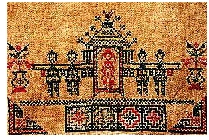
It is feasible that techniques and designs spread from China via India and Egypt to the great civilizations of Greece and Rome and then to the eastern Mediterranean and the Middle East. An alternative school of thought says that the spread of cross-stitched embroidery may have gone in the opposite direction since the first important migration of foreigners into China took place during the Tang Dynasty. Many Persians, Arabs and travelers from Greece and India followed the silk routes into China and eventually settled there. There is evidence that these immigrants influenced the designs of Chinese arts and crafts, particularly textiles. The patterns found on many Chinese textiles are very similar to those found on Persian fabrics.
The only certainty is that the techniques and designs of cross-stitching spread from such countries throughout the European continent. Crusaders probably brought home embroidered textiles from the Middle Eastern countries after the great crusades. The well-traveled trade and spice caravan routes carried not only merchants and their stock of articles for sale but also itinerant craftsmen, who practiced their craft wherever they went. The spread of cross-stitched designs from their place of origin to many different locations makes it difficult to pinpoint the origin of any one design.
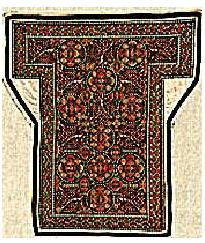
When using table linen, take immediate measures to correct spills and stains: Mop up the excess liquid withpapertowels or tissues and rinse the fabric under running tepid water. Scrape off spilled foods quickly and then blot with a paper towel before washing in the usual way. For stubborn stains, use a solvent or brand-name stain remover, but be sure to test a small area first; if unsure, seek professional advice. When treating stains, remember that it is better to repeat a mild treatment several times rather than using a harsh solvent that may damage both threads and fabrics.
Press the embroidery while it is still slightly damp: Pad an ironing board with a couple of old, clean towels, then lay the embroidery on with the wrong side up. Cover with a piece of clean white fabric (a cotton sheet is ideal). Set your iron to a temperature that corresponds to the fabric's composition, for example, the linen setting for linens, slightly cooler for Aida and cotton fabrics, and even lower for even-woven fabrics made from cotton/viscose mixtures. Press lightly, taking care not to flatten the stitches. Old-fashioned laundry starch will give an attractive, crisp finish to table linen. Make sure the iron is not too hot.
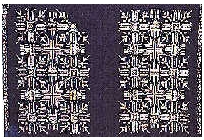
Before storing the cross-stitched works, make sure they are clean and dry. Avoid storing fabrics for any length of time in polythene bags since the static electricity created by polythene attracts dirt and dust which will sully the fabric. Sealed polythene bags also prevent natural fibers, such as cotton and linen, from "breathing," which can result in mildew and eventually weaken or rot the fibers. Instead, store small items laid flat, and larger ones rolled around an acid-free cardboard tube protected by layers of white, acid-free tissue paper. For items too large to roll up, fold loosely between layers of white tissue paper, making sure that each fold is padded with tissue. Store all of the items in their own clean fabric bags in drawers, cupboards or other dark, dry and moth-free places. Small fabric bags of dried lavender add a sweet scent and help prevent moths.





